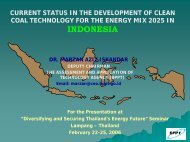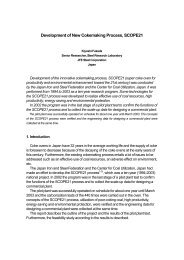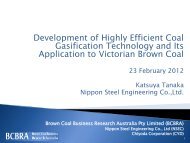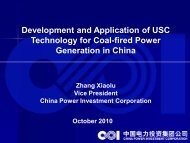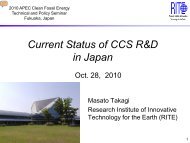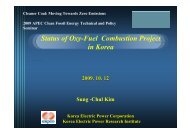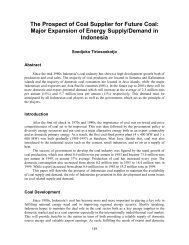Defining CCS Ready: An Approach to An International Definition
Defining CCS Ready: An Approach to An International Definition
Defining CCS Ready: An Approach to An International Definition
- No tags were found...
Create successful ePaper yourself
Turn your PDF publications into a flip-book with our unique Google optimized e-Paper software.
Appendix C: Policy Considerations and Assessments of <strong>CCS</strong> <strong>Ready</strong> EconomicsCarlo analyses by an allowance price in dollars per metric <strong>to</strong>n of CO 2 equivalent. Ifpolicymakers believe that the full social cost of CO 2 emissions will not be reflected in futureallowance prices, these economic analyses performed from a private sec<strong>to</strong>r perspective canbe adjusted <strong>to</strong> reflect the added benefit when <strong>CCS</strong> is applied.In addition <strong>to</strong> the “Base Case” analysis, we conducted several Sensitivity Cases <strong>to</strong> assess theimplications of 1) the timing of general GHG policy implementation, 2) the pricing of naturalgas and electricity, and 3) potential commercialization of advanced capture technology. Thesimulations illustrate how such analyses can be performed, while also drawing some generalconclusions about the economics of <strong>CCS</strong> <strong>Ready</strong>, presented below. The results can be usedfor assessing alternative scenarios and costs.The approach for the Monte Carlo analyses consisted of following steps:1) Define the <strong>CCS</strong> <strong>Ready</strong> options for evaluation. (e.g., a BAU not <strong>CCS</strong> <strong>Ready</strong> case; andthree <strong>CCS</strong> <strong>Ready</strong> cases based on the “throttle valve,” “clutch case,” and “oversizeboiler” plant design options defined in Appendix B);2) Define the possible <strong>CCS</strong> retrofit options (e.g., do not retrofit and incur CO 2 emissioncosts, retrofit <strong>to</strong> current <strong>CCS</strong> technology, or retrofit <strong>to</strong> an advanced <strong>CCS</strong> technology ifavailable);3) Define the decision criteria for determining if and when plants will retrofit <strong>to</strong> <strong>CCS</strong>. Inthis analysis the criteria was that a retrofit would be done if it increased the net presentvalue of the power plant;4) Estimate probability distributions for the year when GHG policy will be implemented,key costs and price variables and the year when an advanced <strong>CCS</strong> technology will becommercialized; and5) For each given Monte Carlo scenario (i.e. a specific combination of costs, prices, andinitiation dates) and for each year of operation, simulate the operation of four plant typeand determine if and when they retrofit <strong>to</strong> <strong>CCS</strong>; then calculate the plants’ annual cashflows and the life cycle net present value of the plants for each Monte Carlo scenario.The lifecycle net present value of the plant is all revenues received by the plant minus allcosts discounted back <strong>to</strong> the first year of operation. A <strong>CCS</strong> <strong>Ready</strong> plant design would beconsidered economic if it would increase the expected net present value of the BAU plant.Stated in other words, the increase (decrease) in the net present value versus the BAUplant represent the economic gain (lose) from the particular <strong>CCS</strong> <strong>Ready</strong> plant design.C.4.1 <strong>CCS</strong> <strong>Ready</strong> and <strong>CCS</strong> Retrofit Options for EvaluationInitial <strong>CCS</strong> <strong>Ready</strong> costs and associated future savings in <strong>CCS</strong> retrofit and operating cost willvary across jurisdictions and among plant types and site locations. However, as anillustration of costs and how they can be analysed, the costs for new pulverized coal-firedpower plant built in the United States at different degrees of readiness is provided here. It isassumed that post-combustion capture technology will be used for retrofitting the plant <strong>to</strong>capture. The plant assumptions are based on the four capture ready plant design casescontained in Appendix B:23 February 2010 107



